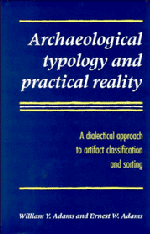 Archaeological Typology and Practical Reality
Archaeological Typology and Practical Reality Published online by Cambridge University Press: 23 November 2009
Family N Group N.VII
Ware W14. Terminal Christian decorated white ware
A rather heavy matte white ware decorated in Style N.VII; the most distinctive ware of the Terminal Christian period. It is presumably evolved from Wares W15 and W16 in Group N. VI, but is distinguished from them by its bolder and simpler decorative style and a distinctive, rather heavy group of vessel forms.
CONSTRUCTION: Wheel-made.
FABRIC: Paste: Nile mud. Density: Medium. Texture: Medium. Color: Tan, light brown or red-brown shading to darker, often purplish core (typical Munsell signatures 2.5YR 4/5, 2.5YR 6/6). Carbon streak: Occasional; seldom dark. Hardness: Generally medium soft (Mohs' value 2.5 to 4.5, av. 3.0). Solid temper: Fairly abundant fine sand, black and red fragments. Organic temper. None seen. Variability: Apparently low. Remarks: Same fabric as Ware R28.
SURFACES: Covering: Medium thick, soft slip. Finish: Matte or sometimes lightly polished. Texture: Usually rather chalky or gritty. Configuration: Level; rotation marks not prominent on interiors. Variability: Surfaces may be matte or lightly polished; never glossy.
VESSEL FORMS: Most common forms: Cups, plain bowls, vases (Fig. 11). Less common forms: Goblets, footed bowls, lids, jars (Fig. 11). Forms not illustrated: A9, A20, A23, D44, D47, F27A, Q6. Doubtful forms: C12, C34, C42, F16. Vessel sizes: Mostly medium. Rims: Rounded, frequently thickened. Bases: Ring almost completely absent; a few examples of very low, solid ring base on footed vessels. Wall thickness: Generally notably thick., especially in larger vessels (7–13 mm, av. 9.6 mm). Execution: Generally fairly precise.
To save this book to your Kindle, first ensure [email protected] is added to your Approved Personal Document E-mail List under your Personal Document Settings on the Manage Your Content and Devices page of your Amazon account. Then enter the ‘name’ part of your Kindle email address below. Find out more about saving to your Kindle.
Note you can select to save to either the @free.kindle.com or @kindle.com variations. ‘@free.kindle.com’ emails are free but can only be saved to your device when it is connected to wi-fi. ‘@kindle.com’ emails can be delivered even when you are not connected to wi-fi, but note that service fees apply.
Find out more about the Kindle Personal Document Service.
To save content items to your account, please confirm that you agree to abide by our usage policies. If this is the first time you use this feature, you will be asked to authorise Cambridge Core to connect with your account. Find out more about saving content to Dropbox.
To save content items to your account, please confirm that you agree to abide by our usage policies. If this is the first time you use this feature, you will be asked to authorise Cambridge Core to connect with your account. Find out more about saving content to Google Drive.